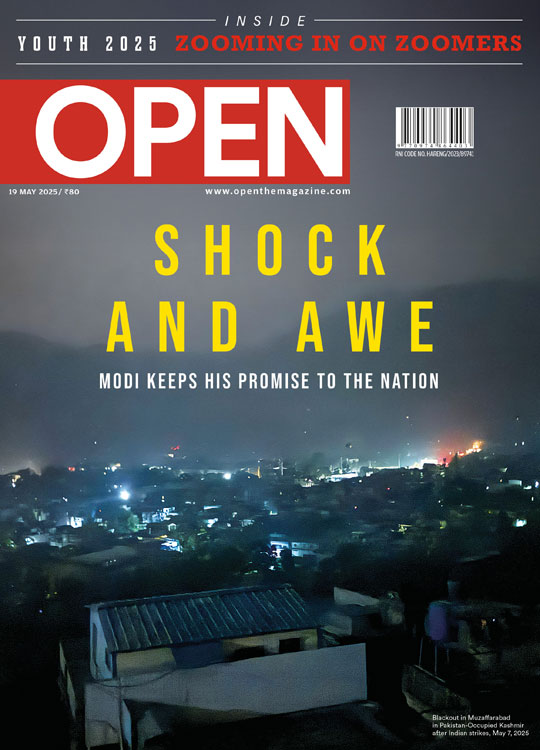Is There an Identity Crisis?
When the search for cultural authenticity stifles imagination
 Poorna Swami
Poorna Swami
 Poorna Swami
Poorna Swami
 |
12 Sep, 2018
|
12 Sep, 2018
/wp-content/uploads/2018/09/Identitycrisis1_0.jpg)
NINETY DANCERS CHECK into a hotel in Chennai. That might sound like the beginning of a bad or bizarre joke but, in fact, was the beginning of an important congregation of young contemporary dancers and dance makers from around the country. Every other year, several choreographers apply to the Prakriti Excellence in Contemporary Dance Awards (PECDA)—organised by the Chennai-based arts foundation, Prakriti— with videos of short works in progress. A handful of these dance pieces are then selected for a public showcase, where a jury of artists and arts professionals choose one work that is awarded a development grant and a tour with the Park New Festival. The work’s choreographer is also given a mentorship with an established choreographer, which in the past have included veterans such as Akram Khan and Jayachandran Palazhy. In a country with a small but rapidly expanding contemporary dance landscape, PECDA is one of the few platforms (including others such as Attakkalari in Bengaluru and Gati Dance Forum in Delhi) that provides institutional support to young dance makers.
This year, the fourth edition of PECDA took place at the end of August in Chennai’s Museum Theatre. The competition showcased works by 21 choreographers. Aseng Borang’s Erosion of Tangko, a promising work that deals with racial othering, assimilation and resistance between the North-East and ‘mainland Indians’, was chosen as this year’s winner. On a sparse stage with white paper mobiles hanging from the ceiling, Borang performs a solo in a series of mini episodes. Her body remains the focal point, transforming from unrelenting to a subtler creature— carefully manipulating its physical features between beautiful and grotesque. In one episode, Borang stands before the audience, using her fingers to pull and push at the shape of her eyes. The work’s politics aren’t hard to read, even though they are morphed and reconfigured within Borang’s more abstract movement and fragmentary storytelling.
Although not fully realised (as no work in progress should be), Erosion of Tangko is a work that I, as a young choreographer and dancer myself, am interested in seeing develop. Most often, that space to grow initial ideas into more nuanced visions is precisely what dance makers in India struggle with. While not every experiment needs a long life, it is very difficult to create full-length works, and even more difficult to run them for multiple shows. Given the dearth of subsidies (in space and money), making dance works is an incredibly unsustainable project. Moreover, contemporary dance that is removed from Bollywood and its kindred television dance reality shows has a very small audience. The dedicated contemporary dance-going audience that one might find in Europe or North America—places with longer histories of dance calling itself ‘modern’ or ‘contemporary’— has yet to emerge in India. Indeed, when we perform our works, we often seem to be performing for each other.
PECDA’s financial investment in dance makers like Borang, in that sense, is commendable. The winner of the competition receives money to create work and also a platform on which to display it. There also seems within the framework of PECDA a desire to nurture artists rather than only fund them. Participants are given feedback about their works and many, whether or not they win, stay in touch with jury members as they continue working on their pieces beyond PECDA. But with so many unsupported artists struggling to make their art and also a living, I wonder if sporadic financial aid is actually what dance needs, and whether funding one artist through a competitive format makes a difference to the broader landscape; there are simply too many dance makers desperate for the means to create their art. Watching works by my peers at PECDA became for me a moment to reflect on an array of bigger questions about contemporary dance and its current moment. Even as we say that dance is growing, is it also in a state of crisis? Under these conditions, what must audiences expect from dance artists? And what is our obligation, as artists, to our field?
MOST CHOREOGRAPHERS in India are not primarily choreographers. Most (like myself) begin as dancers and often dance in their own works, or at least continue to dance in other people’s works even as they make their own. In most cases, a person’s technical training outweighs their choreographic training because most dance schools train dancers and not choreographers. And for the small number of people attempting to choreograph, there are almost too many dancers to go around. This problem isn’t peculiar to India—the disparity between the number of dancers and choreographers is a common story even in dance hubs around the world. And everywhere, dancers are meeting the need for makers themselves.
If our dances are being funded for their departure from the international and into the exotic, of course makers are going to be compelled to tailor their work to don particular identities
Over the years, I have seen the slow transformation of dancers to dance makers all around me. People who were company dancers are now dedicatedly making their own work. But that transformation has been uneven and largely unguided. As I see it, younger choreographers have not had time to fully wade through their political stances and aesthetic desires. They are trained in physical skill but not so much in conceptual thinking. At the PECDA showcase, this nascency was apparent. Although Borang’s piece, along with a few others’, displayed cohesive political articulation and considered dramaturgical thought, there were several other works that struggled to break out of borrowed vocabularies and half-baked conceptual frameworks.
Acrobatic movements interspersed with haphazard text, violent and violated representations of women without adequate reflexivity, and esoteric concept notes to explain seemingly unrelated choreography jarred. The overbearing presence of thematic or topical work that claimed a political progressiveness in its commentary—whether on class, civic engagement or gender—on the one hand, reflected a certain political urgency in the preoccupations of choreographers but, on the other hand, also highlighted a kind of patchwork mode of making work. Physical composition was often compromised in favour of symbolic props or obvious, protest-like text. And frontal, prosaic choreographies were aplenty. The want of rigorous thought, in movement vocabulary and political claim, bothered me.
Of course, I am not expecting pristine works all around. The space for young artists to risk and fail is important, uncompromisable even. But I also wonder how much are we, as a community of dancers and makers, actually risking? If we claim a work is for a feminist cause, why are we reproducing hackneyed images of women in order to supposedly subvert them? Maybe then we aren’t digging deep enough into the questions that plague us.
Although competition rules don’t prescribe the length of a process, perhaps the brevity of the competition piece has led to briefer processes, which in turn has meant that dances haven’t had time to stew, to work out their origins and where they hope to arrive. The nature of a contest is such that people are compelled to apply—in a funding desert, there is the rare hope of resources at the end. It is, in many ways, an efficient way to bring together diverse perspectives. But in a bid to enter this competitive space, I wonder if several makers are pandering to the showcase format. In making works that want to meet multiple expectations—of content, virtuosity and accessibility—choreographers seem to have compromised concentrated investigation. Movement and imagery seem derivative of other work perhaps because dance makers are not taking the time to return what they have borrowed or, more essentially, the time to reclaim it.
This lack of time is not limited to a single platform. Rather, it seems to be a condition in which dance finds itself. Few young makers are delving into lengthy process (often for economic reasons) and that truncation is often visible in the clarity and originality of the work. Perhaps, then, it isn’t funding in and of itself that matters. Perhaps what dance really needs is funding that can buy it time. Not time for an individual but for a culture of dance making itself. Time in the studio. Time to learn histories of dances past. Time to evaluate and reflect upon what our dances are really saying as they play out.
It would be unfair to assume that the selected works at PECDA are somehow representative of all the currents within dance today. PECDA is, after all, one particular format—a small group of participants is chosen along one particular rubric, set of aesthetic preferences and intellectual priorities. Also, not everyone who is making work applies to the competition. To remember that there is a world of dance outside PECDA is important if we are to think about the future possibilities for dance in India.
PECDA generally receives very few abstract entries. Although this year’s showcased works were largely content- driven (and several, didactic even), there are young makers like Meghna Bhardwaj, Deepak Kurki Shivaswamy and Abhilash Ningappa (all past PECDA competitors) who are investigating a deeper abstraction of the body and its politics. Still, the visibility of thematic dance works is far stronger, both within PECDA and outside it.
Indian dance in recent decades has been weighed down by a tussle with its history of narrative dance forms. A reductive binary between the classical and contemporary continues to prod at the legitimacy contemporary dance keeps trying to attain for itself, and abstraction is often lumped as ‘Western’. The need for contemporary dance makers to prove their works as ‘Indian’ has stayed at the centre of dance discourse for many years. This pressure has been accumulating from different directions. Historically, dance in India (particularly Bharatanatyam, after Independence) has been used as a cultural flag bearer to disseminate a state-approved morality.
Also, contemporary dance in India is primarily funded by European cultural organisations, and mentorship platforms for young artists are also filled with Europeans. Although this dynamic has produced many encounters and exchanges between Indian and non-Indian artists, many of our points of reference for what contemporary dance could look like are imported. To reject the European presence would be to undo a large part of Indian dance history and that isn’t my suggestion. Rather, it is to reconsider how we have arrived at our current moment in dance. I see that several young choreographers have yet to emerge out of European markers of what makes good work—either these artists are reproducing European movement vocabularies or framing them within iconised representations of Indian culture. If our dances are being judged and funded for their departure from the international and into the exotic, of course makers are going to be compelled to tailor their work to don particular identities. And it is not the use of clay chai cups or Kathak ghungroos as chains that is inherently problematic. Rather, it is that these choices rarely transcend embellishment.
The overarching thematic trend in contemporary dance could be read as an attempt on the part of young makers to justify the relevance of their practices. If they are charged with refuting the ‘Indianness’ of traditional forms, maybe they are turning to obviously readable Indian political and topical content to respond to this criticism. While I do not mean to dismiss the real political concerns of young dancers and makers, perhaps the general resistance to more porous and less message-oriented work is feeding into the notion that contemporary dance must somehow embody a national identity. To me, this demand seems almost ridiculous. If the arts are meant to encourage a plurality of perspectives, why are we expecting a singular identity for our dance artists? Most dangerously, that expectation for a cultural authenticity (from both within and outside) enforces narrow sanctions upon the imaginations of our young artists. Perhaps authenticity should not be the yardstick at all—it is too shifty a notion. Maybe what we need to ask of our dances is reflection and conversation. For us young makers, these are the things that might help us find depth and rootedness in our practices, even if we don’t know what those might look like. And these are the things I wish we would hold each other to, especially in spaces that allow us to congregate and commune.

/wp-content/uploads/2025/05/Cover-War-Shock-1.jpg)













More Columns
India hammers Pak air bases at Rafiqui, Murid, Chaklala, and Rahim Yar Khan in a show of unflinching force Open
How India (re)built its defence preparedness and war readiness V Shoba
Cracks in the Pink Fortress Open